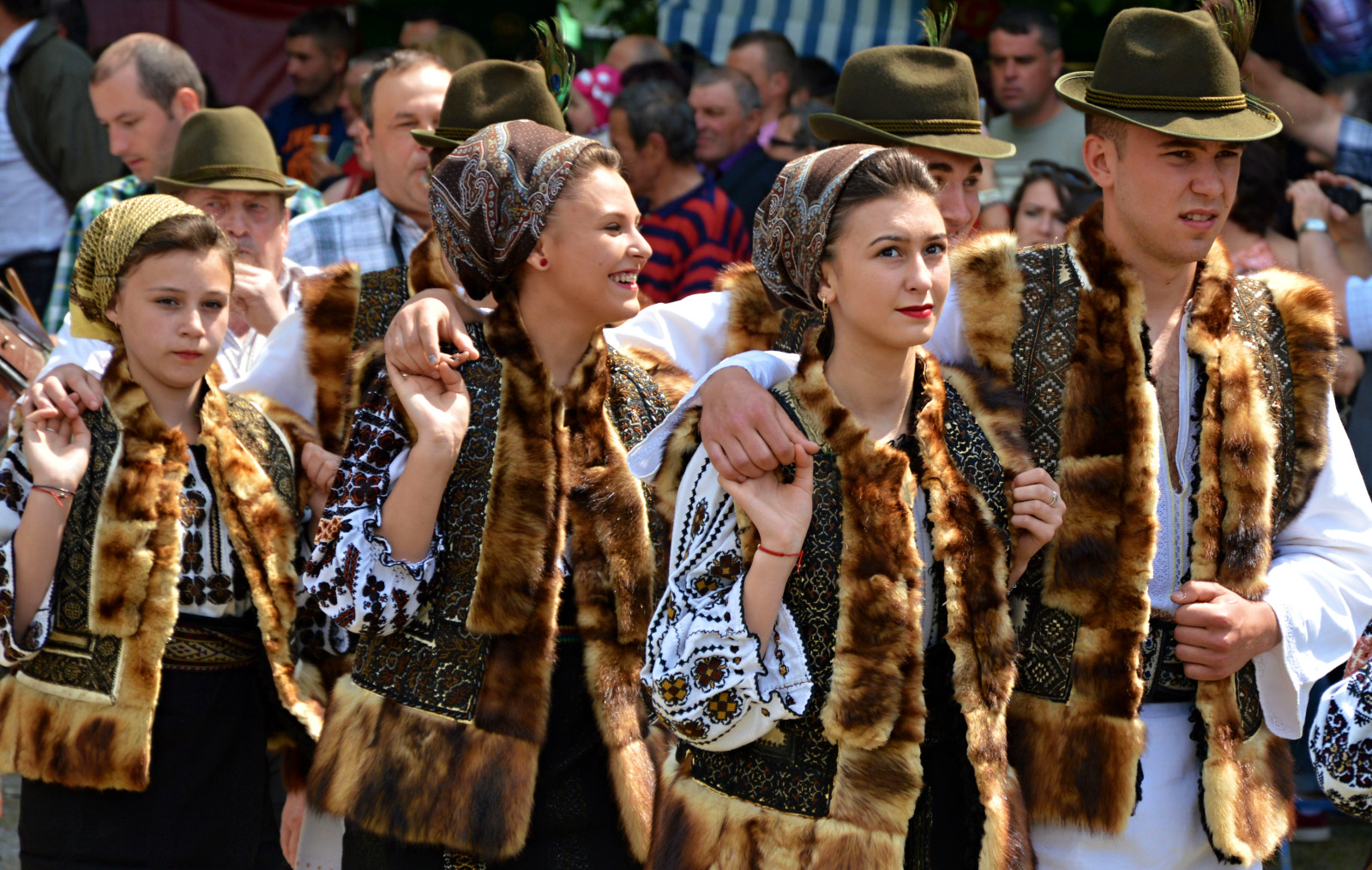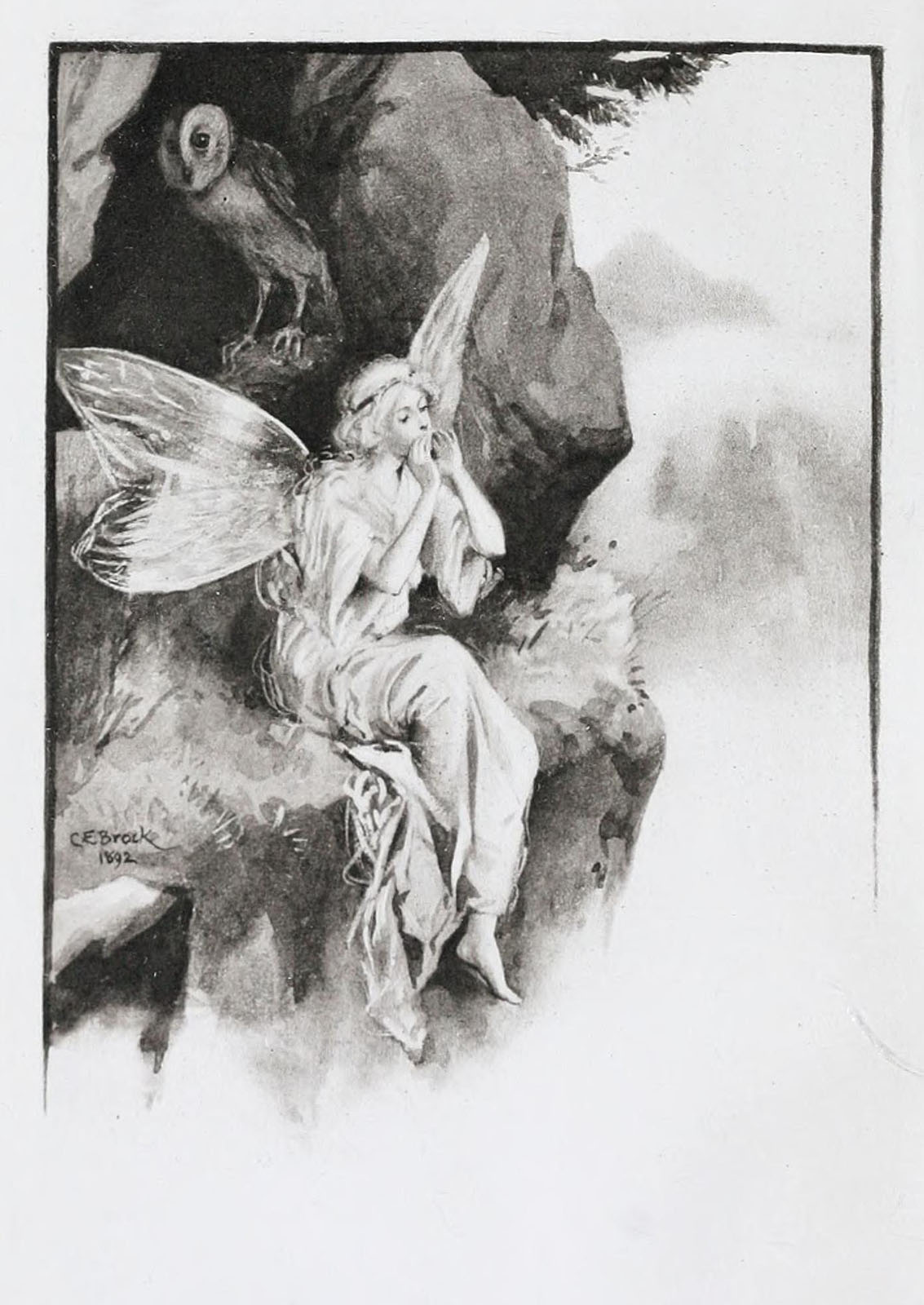|
Sântoaderi
The Sântoaderi were a group of supernatural entities found in Romanian folklore. Viewed as either seven or nine young men with long feet and hooves, they were also thought of as wearing capes. It was believed that they would mysteriously appear in a village, where they would sing, beat their drums, and cause illness for people; wrapping them up in chains causing rheumatism or stamping on their bodies. Upon hearing their music and the sound of hooves, people were advised to stay indoors, which was considered safe. Those that did not retreat indoors, could be kidnapped by the Sântoaderi and made part of the procession. The victims of such kidnappings would sometimes return in healthy condition and carrying gifts; other times, they would return sick, dying, or insane. The Sântoaderi share some similarities with the fairies of Irish folklore. The Romanian historian Mircea Eliade also noted a similarity between the Sântoaderi and the '' zîne'', the Romanian equivalent of the fairy ... [...More Info...] [...Related Items...] OR: [Wikipedia] [Google] [Baidu] |
Mircea Eliade
Mircea Eliade (; – April 22, 1986) was a Romanian History of religion, historian of religion, fiction writer, philosopher, and professor at the University of Chicago. One of the most influential scholars of religion of the 20th century and interpreter of religious experience, he established paradigms in religious studies that persist to this day. His theory that Hierophany, ''hierophanies'' form the basis of religion, splitting the human experience of reality into Sacred-profane dichotomy, sacred and profane space and time, has proved influential.Wendy Doniger, "Foreword to the 2004 Edition", Eliade, ''Shamanism'', p. xiii One of his most instrumental contributions to religious studies was his theory of Eternal return (Eliade), ''eternal return'', which holds that myths and rituals do not simply commemorate hierophanies, but (at least in the minds of the religious) actually participate in them. Eliade's literary works belong to the Fantastique, fantastic and Autobiographical n ... [...More Info...] [...Related Items...] OR: [Wikipedia] [Google] [Baidu] |
Romanian Folklore
The folklore of Romania is the collection of traditions of the Romanians. A feature of Romanian culture is the special relationship between folklore and the learned culture, determined by two factors. First, the rural character of the Romanian communities resulted in an exceptionally vital and creative traditional culture. Folk creations (the best known is the ballad Miorița) were the main literary genre until the 18th century. They were both a source of inspiration for cultivated creators and a structural model. Second, for a long time learned culture was governed by official and social commands and developed around courts of princes and boyars, as well as in monasteries. Overview Creation of the world Stories suggest God made the Earth with the help of animals, while the Devil was trying to thwart his plans.Cosma, Aurel. ''Cosmogonia poporului român'' (The Cosmogony of the Romanian People) (1942). Bucharest: Tipografia Ziarului "Universul".Leeming, David Adams. ''Creati ... [...More Info...] [...Related Items...] OR: [Wikipedia] [Google] [Baidu] |
Călușari
The Călușari (, ; ; singular: Călușar) are the participants to an old traditional Romanian dance known as the . "Căluș" translates to horse, but in an endearing form. Originally Romanian, the practice later spread to North Bulgaria. From three weeks after Easter until Pentecost, called in Romanian, for around two weeks they have traditionally travelled to all their local communities where they would dance, accompanied by a few fiddlers. History The origins of the Călușari are unknown, although the first written attestations are from the 17th-century musical notations of Ioan Căianu. Romanian historian of religion Mircea Eliade noted that "Although the oath taken is made in the name of God, the mythico-ritual scenario enacted by the calusari has nothing in common with Christianity" and that, in the 19th century at least, there was clerical opposition to the group, with its members being excluded from taking communion for three years in some regions. Etymology ... [...More Info...] [...Related Items...] OR: [Wikipedia] [Google] [Baidu] |
Supernatural
Supernatural phenomena or entities are those beyond the Scientific law, laws of nature. The term is derived from Medieval Latin , from Latin 'above, beyond, outside of' + 'nature'. Although the corollary term "nature" has had multiple meanings since the ancient world, the term "supernatural" emerged in the Middle Ages and did not exist in the ancient world. The supernatural is featured in folklore and religious contexts, but can also feature as an explanation in more secular contexts, as in the cases of superstitions or belief in the paranormal. The term is attributed to non-physical entity, non-physical entities, such as angels, demons, gods and ghost, spirits. It also includes claimed abilities embodied in or provided by such beings, including Magic (supernatural), magic, telekinesis, levitation (paranormal), levitation, precognition and extrasensory perception. The supernatural is hypernymic to religion. Religions are standardized supernaturalist worldviews, or at least m ... [...More Info...] [...Related Items...] OR: [Wikipedia] [Google] [Baidu] |
Rheumatism
Rheumatism or rheumatic disorders are conditions causing chronic, often intermittent pain affecting the joints or connective tissue. Rheumatism does not designate any specific disorder, but covers at least 200 different conditions, including arthritis and "non-articular rheumatism", also known as "regional pain syndrome" or "soft tissue rheumatism". There is a close overlap between the term soft tissue disorder and rheumatism. Sometimes the term "soft tissue rheumatic disorders" is used to describe these conditions. The term "Rheumatic Diseases" is used in MeSH to refer to connective tissue disorders. The branch of medicine devoted to the diagnosis and therapy of rheumatism is called rheumatology. Types Many rheumatic disorders of chronic, intermittent pain (including joint pain, neck pain or back pain) have historically been caused by infectious diseases. Their etiology was unknown until the 20th century and not treatable. Postinfectious arthritis, also known as react ... [...More Info...] [...Related Items...] OR: [Wikipedia] [Google] [Baidu] |
History Of Religions
The history of religion is the written record of human religious feelings, thoughts, and ideas. This period of religious history begins with the invention of writing about 5,200 years ago (3200 BCE). The prehistory of religion involves the study of religious beliefs that existed prior to the advent of written records. One can also study comparative religious chronology through a timeline of religion, or the interrelationships and historical diversification of religious ideologies through the use of evolutionary philosophy and broad comparativism. Writing played a major role in standardizing religious texts regardless of time or location and making easier the memorization of prayers and divine rules. The concept of "religion" was formed in the 16th and 17th centuries. Sacred texts like the Bible, the Quran, and others did not have a word or even a concept of religion in the original languages and neither did the people or the cultures in which these sacred texts were written. ... [...More Info...] [...Related Items...] OR: [Wikipedia] [Google] [Baidu] |
Fairy
A fairy (also called fay, fae, fae folk, fey, fair folk, or faerie) is a type of mythical being or legendary creature, generally described as anthropomorphism, anthropomorphic, found in the folklore of multiple European cultures (including Celtic mythology, Celtic, Slavic paganism, Slavic, Germanic folklore, Germanic, and French folklore, French folklore), a form of Supernatural#Spirit, spirit, often with metaphysical, supernatural, or preternatural qualities. Myths and stories about fairies do not have a single origin but are rather a collection of folk beliefs from disparate sources. Various folk theories about the origins of fairies include casting them as either demoted angels or demons in a Christian mythology, Christian tradition, as deities in Paganism, Pagan belief systems, as Spirit (supernatural entity), spirits of the dead, as Prehistory, prehistoric precursors to humans, or as spirits of nature. The label of ''fairy'' has at times applied only to specific Magic (su ... [...More Info...] [...Related Items...] OR: [Wikipedia] [Google] [Baidu] |
Irish Folklore
Irish folklore () refers to the folktales, balladry, music, dance and mythology of Ireland. It is the study and appreciation of how people lived. The folklore of Ireland includes banshees, fairies, leprechauns and other mythological creatures, and was typically shared orally by people gathering around, sharing stories. Many tales and legends were passed from generation to generation, so were the dances and song in the observing of important occasions such as weddings, wakes, birthdays and holidays or, handcraft traditions. Definition What constitutes Irish folklore may be rather fuzzy to those unfamiliar with Irish literature. Diarmuid Ó Giolláin, for one, declared that folklore was elusive to define clearly. Bo Almqvist (c. 1977) gave an all-encompassing definition that folklore covered "the totality of folk culture, spiritual and material", and included anything mentioned in Seán Ó Súilleabháin's ''A Handbook of Irish Folklore'' (1942). It was not until 1846 that th ... [...More Info...] [...Related Items...] OR: [Wikipedia] [Google] [Baidu] |
Cambridge Scholars Publishing
Cambridge Scholars Publishing (CSP) is an academic book publisher based in Newcastle upon Tyne, England. It is not affiliated with the University of Cambridge or Cambridge University Press. It began as the hobby project of a Cambridge alumnus publishing out-of-print Victorian novels. Since then, it has expanded into health science, life science, physical science, and social science. In 2018 it published 729 books. It is known for its aggressive solicitation of authors via email, and uses print on demand techonology to publish a large number of titles every year under a low margin business model, with limited editorial oversight of published works. Although Cambridge Scholars does not charge its authors, it has been listed as a predatory publisher by Cabells' Predatory Reports. Business model Cambridge Scholars Publishing aggressively solicits academic authors via email using information found online, such as recently graduated PhD students with offers to publish their thes ... [...More Info...] [...Related Items...] OR: [Wikipedia] [Google] [Baidu] |
Easter
Easter, also called Pascha ( Aramaic: פַּסְחָא , ''paskha''; Greek: πάσχα, ''páskha'') or Resurrection Sunday, is a Christian festival and cultural holiday commemorating the resurrection of Jesus from the dead, described in the New Testament as having occurred on the third day of his burial following his crucifixion by the Romans at Calvary . It is the culmination of the Passion of Jesus, preceded by Lent (or Great Lent), a 40-day period of fasting, prayer, and penance. Easter-observing Christians commonly refer to the last week of Lent, before Easter, as Holy Week, which in Western Christianity begins on Palm Sunday (marking the entrance of Jesus in Jerusalem), includes Spy Wednesday (on which the betrayal of Jesus is mourned), and contains the days of the Easter Triduum including Maundy Thursday, commemorating the Maundy and Last Supper, as well as Good Friday, commemorating the crucifixion and death of Jesus. In Eastern Christianity, t ... [...More Info...] [...Related Items...] OR: [Wikipedia] [Google] [Baidu] |







